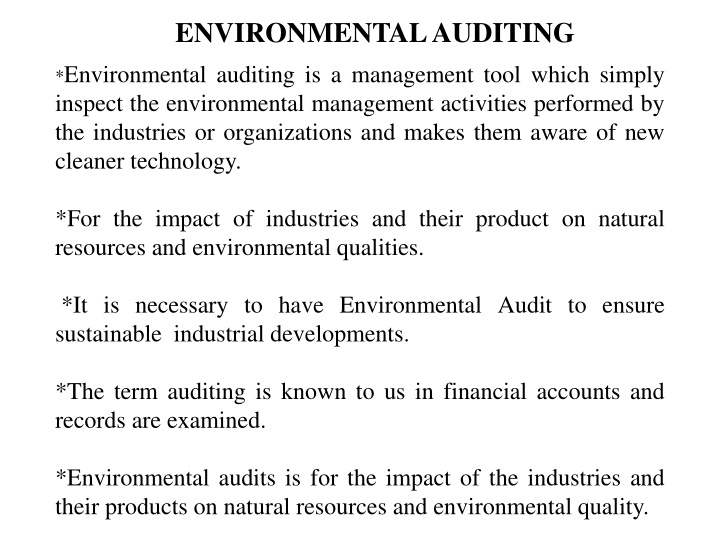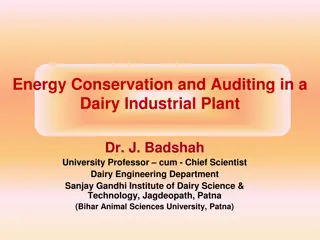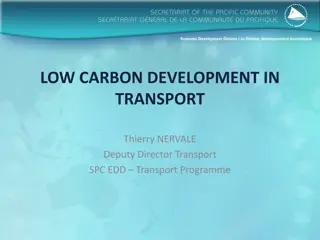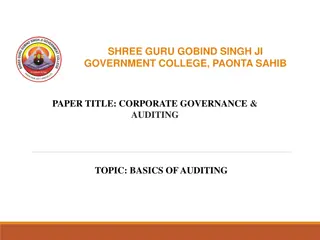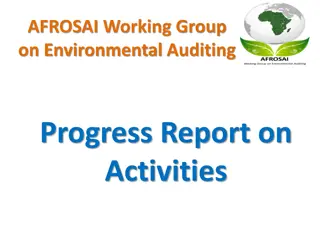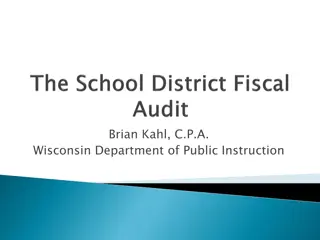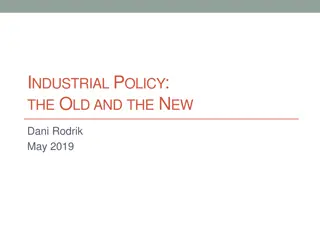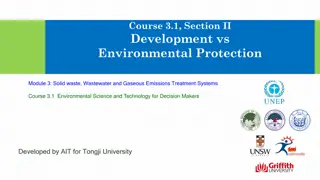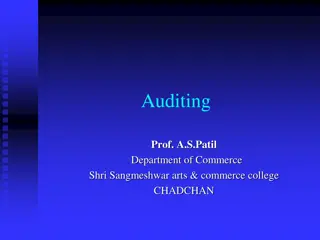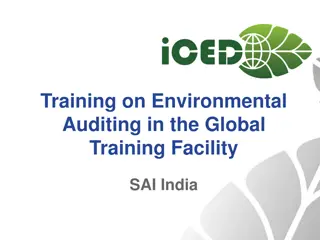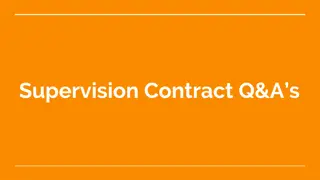Environmental Auditing for Sustainable Industrial Development
Environmental auditing is a management tool that assesses the impact of industries on natural resources and environmental quality. It ensures compliance with laws, improves efficiency, mitigates risks, and promotes stakeholder engagement.
Download Presentation

Please find below an Image/Link to download the presentation.
The content on the website is provided AS IS for your information and personal use only. It may not be sold, licensed, or shared on other websites without obtaining consent from the author.If you encounter any issues during the download, it is possible that the publisher has removed the file from their server.
You are allowed to download the files provided on this website for personal or commercial use, subject to the condition that they are used lawfully. All files are the property of their respective owners.
The content on the website is provided AS IS for your information and personal use only. It may not be sold, licensed, or shared on other websites without obtaining consent from the author.
E N D
Presentation Transcript
ENVIRONMENTAL AUDITING *Environmental auditing is a management tool which simply inspect the environmental management activities performed by the industries or organizations and makes them aware of new cleaner technology. *For the impact of industries and their product on natural resources and environmental qualities. *It is necessary to have Environmental Audit to ensure sustainable industrial developments. *The term auditing is known to us in financial accounts and records are examined. *Environmental audits is for the impact of the industries and their products on natural resources and environmental quality.
BENEFITS OF ENVIRONMENTAL AUDITING *Improves efficiency of environmental management system. *Compliance with environmental law and standards. *Risk mitigation *Meeting stakeholders expectations *Reduction in operational inefficiencies *Encourages continual improvement *Compliance with certification requirements *Employee awareness *Helps management in decision making * It helps in assessing compliance with regulatory requirement. * It also helps in prevention control of effect of pollutant
Material Audit-It mainly concentrate on the use of different raw material or natural use of resources, cost\unit, process wise consumption, wastage etc. Conservation of raw material, scientific storage & reuse of wastage material are taken into consideration. Energy Audit- It examines consumption of various forms of energy in different processes in any industry or organization. The main of audit is minimization, elimination of avoidable losses of valuable energy & their conservation. Water Audit- Consumption of water at different sources is noted. It also concentrates on the reuse and recycling of water, evaluation of raw water intake, balancing of water table & other sources. .
Health and Safety Audit- Workers &employee are the basic need of industry. Health and safety of those is well considered in audit. Proper disposal of toxic and hazardous waste, fire prevention measures etc. should be evaluated. Environmental Quality Audit- Conservation of every aspect and stage of environment helps to maintain the quality. This also well noted in audit scheme. Waste Audit: It covers the qualitative and quantities evaluation of waste generated from industries. Engineering Audit-Use of advance technology which will cover the suitable processes and engineering application. Compliance Audit: The different aspect of audits that are required to be carried out as per regulation, procedure & according to the policies of that particular industry are known as compliance audit.
Environmental Audit Activities 1. Pre-audit activities -These include selection of the expert team and development of a plan. There are four key activities. *Submitting pre-visit questionnaire of the facility. *Reviewing relevant regulation. *Defining audit scope and team responsibilities *Reviewing audit check lists. 2. On-site activities- Meeting of the team with the appropriate with the appropriate personnel of the unit The 3 primary functions on site activities are *Record &documentation review *Interview with staff *Physical inspection of the facilities.
3. Post-audit Activities: Development of raw material balance analysis for each process unit of the industry highlighting analysis for each process unit of the industry highlighting the proposed utilization of raw material and ideas regarding reuse can be thought of. Issue of draft report * Issue of final report Advantages of Auditing *Preparation of Environmental management plan. *Assessment of environmental input and risks. *Identifying areas of strength and weakness for improvements. *Evaluation of pollution control. *Verification of compliance with laws * Assuring safety of plant, environment & human beings. *Enhancement of loss prevention, manpower development and marketing. *Budgeting for pollution control, waste prevention, reduction, recycling and reuse. *Providing an opportunity for management to give credit for good environmental performance.
